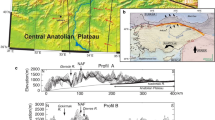Abstract
Three different types of methods are used to assess the ability to determine erosion amounts and to provide estimates of uncertainty. In the situation of dynamical indicator methods, such as seismic velocity, sonic logs, density logs, or drilling exponent methods, intrinsic assumptions and parameter values used provide only a broad statement on the resolution of uplift/erosion events. None of the methods is more accurate, at best, to better than ± 1 km and likely much worse. For geological model procedures, exemplified by considerations of Airy isostasy and by bed upturning near a salt dome in the Nordkapp Basin of the Barents Sea, the uncertainties are again of the order of ± 500–1000 m. With thermal indicator procedures, the bulk of the constraint information from available data is needed to determine paleoheat flux with little left over to constrain the erosion, implying a minimum uncertainty of ± 500 m on erosion determinations. No method seems capable of resolving erosional events to better than a minimum uncertainty of ± 500 m, and likely no better than ± 1 km.
Similar content being viewed by others
References
Berner, H., Ramberg, H., and Stephansson, O., 1972, Diapirism in theory and experiment: Tectonophysics v. 15, no. 1, p. 197–218.
Biot, M. A., and Ode, H., 1965, Theory of gravity instability with variable overburden and com- paction: Geophysics, v. 30, no. 1, p. 213–227.
Bishop, R. S., 1978, Mechanism for emplacement of piercement diapirs: Am. Assoc. Petroleum Geologists Bull., v. 62, no. 10, p. 1561–1583.
Cao, S., Glezen, W. H., and Lerche, I., 1986, Fluid flow, hydrocarbon generation and migration: a quantitative model of dynamical evolution in sedimentary basins: Proc. Offshore Technology Conference, Paper OTC 5182 (Houston, TX), p. 267–276.
Cao, S., Lerche, I., and Hermanrud, C., 1988, Formation temperature estimation by inversion of borehole measurements: Geophysics, v. 53, no. 8, p. 979–988.
Cao, S., Lerche, I., and O’Brien, J., 1989, Impact on hydrocarbon retention of fracturing and faulting around salt sheets in the Gulf Coast: Trans. Gulf Coast Assoc. Geol. Soc., Volume 39, p. 15–26.
Eaton, B. A., 1975, The equations for geopressure prediction from well logs: SPE Paper 5544 (as referenced by Skagen, 1992), unpaginated.
Feller, W., 1957, Introduction to probability theory and its applications, Vol. 1: John Wiley & Sons, New York, 461 p.
Gleadow, A. J. W., Duddy, I. R., and Lovering, J. F., 1983, Fission track analysis: a new tool for the evaluation of thermal histories and hydrocarbon potential: APEA Jour., v. 23, p. 93–102.
Green, P. F., and Duddy, I. R., 1988, Some comments on paleotemperature estimation from apatite fission track analysis: Jour. Petrol. Geology, v. 12, no. 2, p. 110–115.
Hearst, J. R., and Nelson, P. H., 1985, Well-logging for physical properties: McGraw-Hill Book Co., New York, 571 p.
Hottman, C. E., and Johnson, R. K., 1965, Estimation of formation pressures from log-derived shale properties: Jour. Petrol. Tech., v. 17, no. 6, p. 717–722 (as referenced by Sakgen, 1992).
Lerche, I., 1988a, Inversion of multiple thermal indicators: quantitative methods of determining paleoheat flux and geological parameters I. The theoretical development for paleoheat flux: Math. Geology v. 20, no. 1, p. 1–36.
Lerche, I., 1988b, Inversion of multiple thermal indicators: quantitative methods of determining paleoheat flux and geological parameters II. The theoretical development for chemical, physical and geological parameters: Math. Geology, v. 20, no. 1, p. 73–96.
Lerche, I., 1990, Basin analysis: quantitative methods, Vol. 1: Academic Press, San Diego, 561 P.
Lerche, I., 1991, Basin analysis: quantitative methods, Vol. 2, Academic Press, San Diego, 570 P.
Lerche, I., and O’Brien, J., eds., 1987a, Dynamical geology of salt and related structures: Academic Press, San Diego, 839 p.
Lerche, I., and O’Brien, J., 1987b, Modeling of buoyant salt diapirism,in Dynamical geology of salt and related structures: Academic Press, San Diego, p. 129–162.
LØseth, H., Lippard, S. J., Saettem, J., Farnavoll, S., Fjerdingstad, V., Leith, T. H., Ritter, U., Smelror, M., and Sylta, Ø., 1993, Cenozoic uplift and erosion of the Barents Sea-evidence from the Svalis Dome area, Vorren, T., and others, eds.,in Arctic Geology and Petroleum Potential: Elsevier, Amsterdam, p. 643–664.
Magara, K., 1976, Thickness of removed sedimentary rocks, paleopore-pressure and paleotemper- ature, southwestern part of Western Canada Basin: Am. Assoc. Petroleum Geologists Bull., v. 60, no. 4, p. 554–565.
Nettleton, L. L., 1955, History of concepts of Gulf Coast salt dome formation: Am. Assoc. Petro- leum Geologists Bull., v. 39, no. 12, p. 2373–2383.
Oerlemans, J., 1984, Numerical experiments on large scale glacial erosion. Z. Gletscherkd. Gla- zialgeol. v. 20, no. 1, p. 107–126.
Raymer, L. L., Hunt, E. R., and Gardner, J. S., 1980, An improved sonic transit time-to-porosity transform: Soc. Prof. Well Log Analysis, 21st Ann. Logging Symposium (8–11 June 1980), unpaginated.
Sclater, J. G., and Christie, P. A. F., 1980, Continental stretching: an explanation of the post-mid- Cretaceous subsidence of the central North Sea basin: Jour. Geophys. Res., v. 85, no. 3, p. 3711–3739.
Skagen, J. I., 1992, Methodology applied to uplift and erosion: Norsk Geologisk Tidsskrift, v. 72, no. 4, p. 307–311.
Turcotte, D.L., and Schubert, G., 1982, Geodynamics-applications of continuum physics to geo- logical problems: John Wiley & Sons, New York, 450 p.
Vorren, T. O., Bergsager, E., Dahl-Stamnes, Ø. A., Holter, E., Johnansen, B., Lie, E., and Lund, T. B., eds., 1993, Arctic geology and petroleum potential: NPF Spec. Publ. No. 2, Elsevier, Amsterdam, 751 p.
Warren, J. E., 1978, Exploration economics seminar notes: Gulf Research and Development Corporation, Pittsburgh, Pennsylvania, 605 p.
Wyllie, M. R. J., Gregory, J. A. R., and Gardner, L. W., 1956, Elastic wave velocities in heterogeneous and porous media: Geophysics v. 21, no. 1, p. 4–52.
Author information
Authors and Affiliations
Rights and permissions
About this article
Cite this article
Lerche, I. Erosion and uplift uncertainties in the Barents Sea, Norway. Math Geol 29, 469–501 (1997). https://doi.org/10.1007/BF02775084
Received:
Revised:
Issue Date:
DOI: https://doi.org/10.1007/BF02775084




